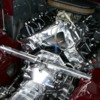quote:
Originally posted by larryw:
George, should the girdle be torqued in place before crankshaft bearing alignment is checked and/or corrected?
My preference would be to align-hone it with the girdle in place.
quote:
Originally posted by LF - TP 2511:
... unless you somehow plan to run road races in the 6000+ rpm range, I don't think he would advise a girdle, either ... George?
I'd rather provide guidelines and let people form their own opinions. It won't hurt anything to install the girdle, even if its not needed. Larry's point about deciding to run the motor harder in the future is a valid one. Girdles are very common with small block Chevys and Windsors, and although the Cleveland lower end is much beefier, Ford engineers specified 4 bolt mains for the 351 Cobra Jet and Boss 351 for a reason, not to waste Ford's money.
-G


